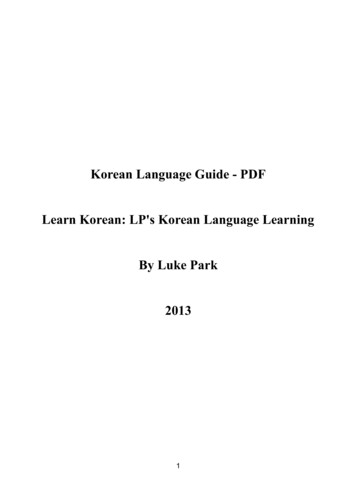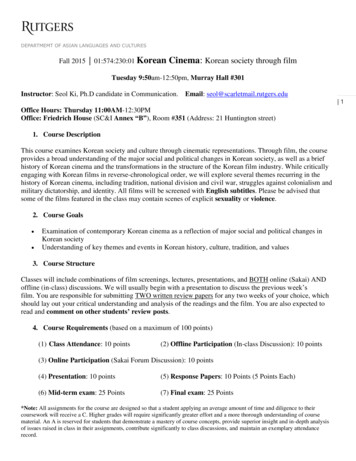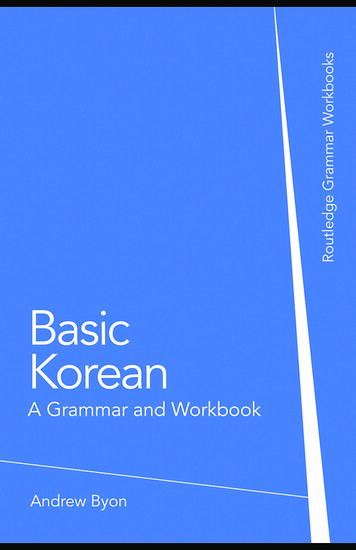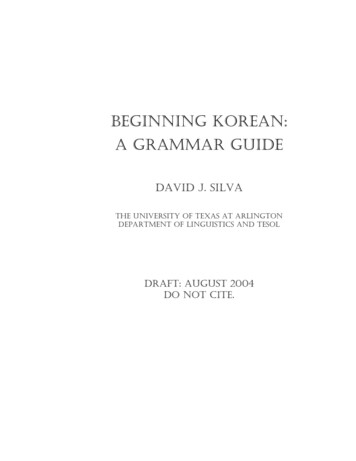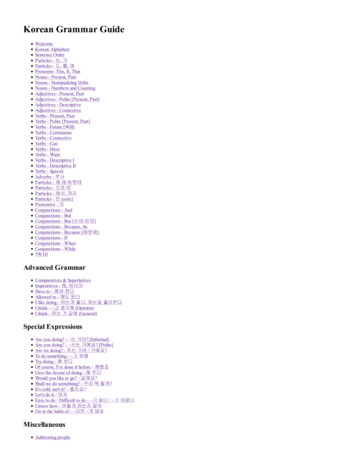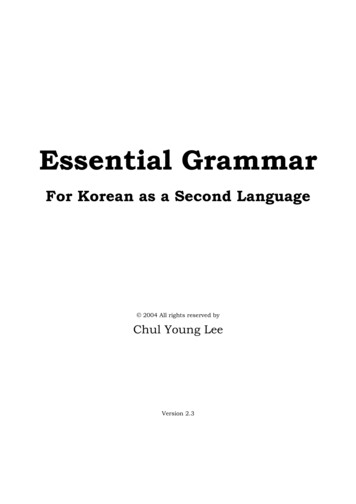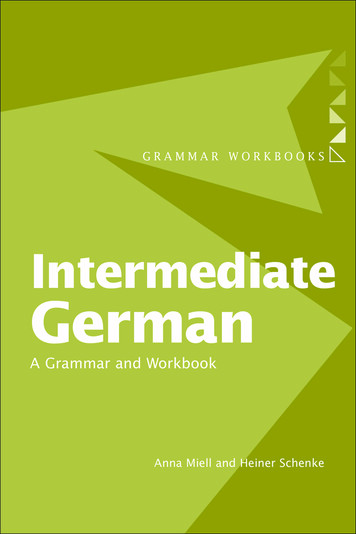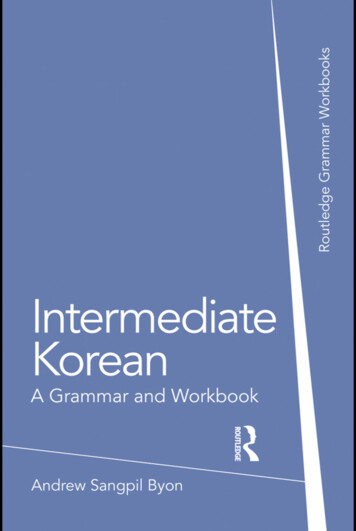
Transcription
INTERMEDIATE KOREAN:A GRAMMAR AND WORKBOOKIntermediate Korean: A Grammar and Workbook comprises anaccessible reference grammar and related exercises in a single volume.This workbook presents twenty-four individual grammar points,covering the core material which students would expect to encounterin their second year of learning Korean. Grammar points are followedby examples and exercises which allow students to reinforce andconsolidate their learning.Intermediate Korean is suitable for both class use as well asindependent study.Key features include: clear, accessible formatmany useful language examplesall Korean entries presented in Hangul with English translationsjargon-free explanations of grammarabundant exercises with full answer keysubject index.Clearly presented and user-friendly, Intermediate Korean providesreaders with the essential tools to express themselves in a wide varietyof situations, making it an ideal grammar reference and practiceresource for students with some knowledge of the language.Andrew Sangpil Byon is Associate Professor at the State University ofNew York at Albany, where he teaches courses in Korean languageand civilization.
Other titles available in the Grammar Workbooks series are:Basic CantoneseIntermediate CantoneseBasic ChineseIntermediate ChineseBasic DutchIntermediate DutchBasic GermanIntermediate GermanBasic IrishIntermediate IrishBasic ItalianBasic KoreanIntermediate KoreanBasic PolishIntermediate PolishBasic RussianIntermediate RussianBasic SpanishIntermediate SpanishBasic WelshIntermediate Welsh
INTERMEDIATE KOREAN:A GRAMMAR ANDWORKBOOKAndrew Sangpil Byon
For my parents, James Ki Yong and Gloria Hye Ja PyonFirst published 2010by Routledge2 Park Square, Milton Park, Abingdon, Oxon OX14 4RNSimultaneously published in the USA and Canadaby Routledge270 Madison Ave, New York, NY10016Routledge is an imprint of the Taylor & Francis Group, an informa businessThis edition published in the Taylor & Francis e-Library, 2009.To purchase your own copy of this or any of Taylor & Francis or Routledge’scollection of thousands of eBooks please go to www.eBookstore.tandf.co.uk. 2010 Andrew Sangpil ByonAll rights reserved. No part of this book may be reprintedor reproduced or utilised in any form or by any electronic,mechanical, or other means, now known or hereafter invented,including photocopying and recording, or in any informationstorage or retrieval system, without permission in writingfrom the publishers.British Library Cataloguing in Publication DataA catalogue record for this book is available from the British LibraryLibrary of Congress Cataloguing-in-Publication DataByon, Andrew Sangpil.Intermediate Korean : a grammar & workbook / Andrew Sangpil Byon.p. cm.Simultaneously published in the USA and Canada.1. Korean language—Grammar—Problems, exercises, etc. 2. Korean language—Textbooks for foreign speakers—English. I. Title.PL913.B965 2009495.7′82421—dc222008053381ISBN 0-203-87590-7 Master e-book ISBNISBN10: 0-415-54714-8 (hbk)ISBN10: 0-415-77488-8 (pbk)ISBN10: 0-208-87590-7 (ebk)ISBN13: 978-0-415-54714-7 (hbk)ISBN13: 978-0-415-77488-8 (pbk)ISBN13: 978-0-203-87590-2 (ebk)
CONTENTS123G4567891011PrefaceixThe intimate speech level and the plain speech level 㠊/㞚, ⓪/ච , /(㦒) ?, 㞚/㠊 , 㧦1Sentence-final endings 㰖㣪, ῆ㣪, 㣪11Particles , 㻮 , ṯ㧊, Ⱒ䋒, Ⱎ , Ⱎ㩖, 㫆㹾, 㠦19Auxiliary verbs I 㠊/㞚G㡺 , 㠊/㞚GṖ , 㠊/㞚G 27Auxiliary verbs II 㠊/㞚G⌊ , 㠊/㞚G Ⰲ , ἶGⰦ , 㠊/㞚G㭒 , 㠊/㞚G Ⰲ 33Auxiliary verbs III 㠊/㞚G , 㠊/㞚G , 㠊/㞚G㧞 , 㠊/㞚䞮 , 㠊/㞚㰖 42Clausal conjunctives (purpose or intention) (㦒) , (㦒) ἶ, G51Clausal conjunctives (reasons and cause) 㠊/㞚 , (㦒) , ἶ61Clausal conjunctives (conditions) (㦒)Ⳋ, 㠊/㞚㟒, (㦒)ඥ㑮 , Ệ 72Clausal conjunctives (listing and choice) ἶ, (㦒)Ⳇ, Ệ , 㰖85Clausal conjunctives (time) (㦒)Ⳋ , 㧦Ⱎ㧦, ṖG95v
12ContentsClausal connectives (background) ⓪ /(㦒)ච 105Clausal connectives (although) 㰖Ⱒ, (㦒) , 㠊/㞚 113Permission, prohibition, and obligation 㠊/㞚 G , (㦒)ⳊG㞞G , 㞞G (㦒)ⳊG㞞G / 㰖G㞠㦒ⳊG㞞G , 㠊/㞚㟒G /䞮 120Passives and causatives 㧊, 䧞, Ⰲ, ₆, 㤆, ῂ, 㿪, ỢG䞮 129The noun-modifying endings ⓪, (㦒)ච, (㦒)ඥ137GDescribing the appearance of actions or states of affair ⓪/(㦒)ච/(㦒)ඥGộGṯ , ⓪/(㦒)ච/(㦒)ඥG⳾㟧㧊 , ⓪/(㦒)ච/(㦒)ඥG 䞮 , /(㦒)චṖG , 㠊/㞚G 㧊 G14618GPost modifiers I₎, 㩗, 㧒, 㞞, 㭧, 㭧, 䘎15719GPost modifiers II , 䤚㠦, 㻯, 㠦, ộ, ㄪ, 16620Ability and possibility (㦒)ඥG㑮G㧞 /㠜 , (㦒)ඥG㭚G㞢 /⳾ , (㦒)ඥGⰂṖG㠜 178Indirect question form ⓪/(㦒)ච/(㦒)ඥ㰖186The retrospective suffix 195Nominalizing endings ₆ and (㦒)ත205Direct and indirect quotation (㧊) ἶG䞮 , ( )ච ἶG䞮 , ἶG䞮 /ⶑ , (㦒) ἶG䞮 , 㧦ἶG䞮 219Key to exercises228Index279131415161721222324vi
PREFACEIntermediate Korean: A Grammar and Workbook is a sequel to its sistervolume Basic Korean: A Grammar and Workbook, and it likewise focuseson providing an accessible reference grammar explanation and relatedexercises in a single volume. It is designed for independent English-speakingadult Korean-as-a-foreign-language (KFL) learners who intend to maintainand strengthen their knowledge of essential Korean grammar and forclassroom-based learners who are looking for supplemental grammarexplanations and practices. Consequently, this book differs from existingKFL materials whose primary purpose is to help KFL learners acquirefour language skills, such as listening, speaking, reading, and writing as wellas cultural knowledge.The layout of this book also differs from those of existing KFL materials. For instance, a typical KFL textbook chapter may include model dialogues, followed by vocabulary lists, grammar explanations, cultural notes,and exercises. In contrast, following the pattern of Basic Korean and otherGrammar Workbooks of the Routledge series, every unit of IntermediateKorean focuses on presenting jargon-free and concise grammar explanations, followed by relevant grammar exercises.This book has 24 units, and it does not take a functional-situationalapproach in grouping and/or sequencing target grammatical points. Ratherit sequences and covers grammatical points according to their grammaticalcategories (e.g., sentence endings, conjunctives, particles, and so on), sothat learners can use the book as a reference material as well as a practicematerial. The exercises at the end of each unit are designed primarily toreinforce the target grammatical points.All Korean entries are presented in Hangul (the Korean alphabet) withEnglish translations to facilitate understanding. Accordingly, it requiresthat learners familiarize themselves with Hangul, before going on to thebook. In addition, when translating Korean entries into English, effortswere made to reflect the Korean meaning as closely as possible. Consequently,some learners may feel certain English translations do not reflect typicalEnglish usages. However, the direct translation approach was employedfor pedagogical purposes.vii
In writing this book, I have been fortunate to have the assistance andsupport of many people. I would like to thank my colleagues in the Department of East Asian Studies at the University at Albany, State Universityof New York, who were supportive of this project. I am grateful to anonymous reviewers for their constructive and valuable comments. I would liketo express sincere gratitude to Sophie Oliver for initially encouraging thisproject and to the editorial and production teams of Routledge—AndreaHartill, and Samantha Vale Noya—for their advice and support throughout the process. My thanks also go to Neil Dowden for his careful andthoughtful copy-editing service and to Kathy Auger at Graphicraft for herkind assistance during the final stage of production. Finally, as always, myspecial thanks go to my wife, Isabel, who, with her optimism and encouragement, makes it possible for me to do what I really love to do. Of course,I bear all responsibility for any shortcomings and errors in the text.Prefaceviii
UNIT 1The intimate speech level andthe plain speech levelThe intimate speech levelThe intimate speech level is in general used in the following situations: byadults when addressing children, by parents when addressing their kids,by children when addressing their peers, and by adult friends when addressing their childhood friends (or friends whose relationships are close enoughto switch to the intimate level from the polite level).The intimate speech level ending is 㠊/㞚. The choice of 㠊 or 㞚 isthe same with that of the polite speech level ending 㠊㣪/㞚㣪. 㞚 isused after a stem that ends in a bright vowel, 㡺 or 㞚 (e.g., 㺔 “find” 㺔㞚), while 㠊 is used with the stem that ends in any other vowels(e.g., 㤆 “learn” 㤢). Consider the following examples:Ṗ “go” 㤆 “learn”Ṗ 䂮 “teach”ⲏ “eat”䞮 “do”㧞 “have/exist”㧊 “be”㞚 “not be”Polite speech levelṖ㣪 㤢㣪Ṗ 㼦㣪ⲏ㠊㣪䟊㣪㧞㠊㣪㧊㠦㣪㞚 㠦㣪Intimate speecsh levelṖ 㤢Ṗ 㼦ⲏ㠊䟊㧞㠊㧊㟒㞚 㟒As seen above, one can generate the intimate speech level from thepolite speech level, simply by removing 㣪. One exception is that thecopula 㧊 /㞚 takes slightly different forms: 㧊㟒 instead of 㧊㠦,and 㞚 㟒 instead of 㞚 㠦.Just like the polite speech level ending 㠊㣪/㞚㣪, the intimate speechlevel ending 㠊/㞚 is used for all sentence types: declarative, interrogative,imperative, and propositive. For instance, consider the following:1
1The intimatespeech leveland the plainspeech levelⰺ㧒G 㠊 “(I) run everyday.”ⰺ㧒G 㠊? “(Do you) run everyday?”ⰺ㧒G 㠊! “Run everyday!”ⰺ㧒G 㠊 “(Let us) run everyday.”Koreans use contextual elements as well as intonation (e.g., rising intonation for a question) to figure out what intimate speech level ending 㠊/㞚 is used for a specific sentence type.The plain speech levelThe plain speech level ending sounds more blunt and direct than otherspeech levels: deferential, polite, and intimate. The plain speech level isprimarily used in the following three contexts: When one addresses a child,his/her childhood friends, or younger siblings; when the speaker talks tohimself/herself or wants to draw the listener’s attention to informationthat is noteworthy or provoking; when one writes (e.g., personal essay,prose, newspaper articles, academic papers, diary, and so forth).Unlike the intimate and the polite speech levels that use the sameendings for different sentence types, the plain speech level has differentendings for different sentence types, as shown below.Declarative ⓪/ච (for verb stems)Ṗ “go”ⲏ “eat”Ὃ 䞮 “study”Ṛ ⲏ⓪ Ὃ 䞲 (for adjective and copula stems)㿻 “cold” 䞮 “clean”㧊 “be”㿻 䞮 㧊 㠞/㞮 (for all predicate stems in the past tense)㞺 ṖG䞯ᾦ㠦GṪ G “Andrew went to school.” 㝾ṖG㿪㤶 G“The weather was cold.” 㧊G 䟞 G“The room was clean.”⁎G 㧦ṖG䞲ῃG 㧊㠞 “That man was a Korean.”2
InterrogativeThe plainspeech level /(㦒) ? (for all predicate stems)Ṗ G“go”ⲏ G“eat”Ὃ 䞮 “study”㫡 “good”㿻 “cold” 䞮 “clean”㧊 “be”Ṗ ? (or Ṗ ?)ⲏ ? (or ⲏ ?)Ὃ 䞮 ? (or Ὃ 䞮 ?)㫡 ? (or 㫡 ?) / 㫡㦒 ? (for writing)㿻 ? (or 㿻 ?) / 㿪㤆 ? (for writing) 䞮 ? (or 䞮 ?)㧊 ? (or 㧊 ?) 㠞/㞮 /(㦒) ? (for all predicate stems in the past tense)㞺 ṖG䞯ᾦ㠦GṪ ? “Did Andrew go to school?” 㝾ṖG㿪㤶 ? “Was the weather cold?” 㧊G 䟞 ? “Was the room clean?”⁎G 㧦ṖG䞲ῃG 㧊㠞 ? “Was that man a Korean?”Imperative (only for verb stems) 㞚 (after a stem that ends in 㡺 or 㞚) 㠊 (after a stem that ends in any other vowels)Ṗ “go”ⲏ “eat”Ὃ 䞮 “study”Ṗ ⲏ㠊 Ὃ 䟊 Propositive (only for verb stems) 㧦Ṗ “go”ⲏ “eat”Ὃ 䞮 “study”Ṗ㧦ⲏ㧦Ὃ 䞮㧦Note that the plain speech level imperative ending 㠊 /㞚 Gand propositive ending 㧦 are used only for verb stems, and they are not conjugatedfor the tense.3
1ExercisesThe intimatespeech leveland the plainspeech levelKey vocabulary for Unit 1 exercisesṖỢ storeṖ bagṖ 䂮 to teachṫ㦮 lectureỊ to cross overἓ㺆ὖ police officerὒ㧒 fruitsὋ 䞮 to studyὋ㡆 public performance/play⁎Ⰲ to draw⁎Ⱂ painting/picture₆ Ⰲ to wait₆ feeling/mood 䞮 to be clean to be bad 㝾 weather⌊ Ṗ to go down older sister feeling/mood Ⰲ to be slow/to be sluggish Ⰲ bridge/legs to close/to shut to be sweet cigarette 㰖 to throw➆⦑䞮 to be warm➆ to follow to depart/to take leave of/to leave ỗ to be hot (water)/to be heated ⰾ㓺 romance4Ⱎ㔲 to drinkⰞ䂮 to finishⰢ to meetⲎⰂ head/hair (of one’s head)ⲏ to eatⲖ to be farⶎ door to trust/to believe to be busy
to receive foot 㤆 to learn Ⰲ to throw away 㓺 bus 㧎Gcriminal ⌊ to send to see/to watch/to readアⰂ to borrowKeyvocabularyfor Unit 1exercises ὒ apple person ⶊ㔺 office 㰚 picture 䙂 package hand㔲䠮 test/examination㔶 to wear (shoes/socks)㔶ⶎ newspapers㕇㕇䞮 to be fresh㝆 ₆ trash/garbage㞑 to wash㞚 not be㞚 the base/the lower part㞚 㰖 father㞚䂾 morning㞚䝚 to be sore/to be painful㟧Ⱖ socks㠊 to be difficult㠎㩲 when㡊 to open㡊㐶 keys㡗䢪 movie㣎䂮 to shout㧊 this time㧒 work/matter/errand㧒 㠊 the Japanese language㧒㹣 early㧓 to read㧛 to wear (clothes)㧦 to sleep㧦㩚Ệ bicycle㧷 to catch/to hold㨂⹎㧞 to be interesting5
㩧㔲 dishes/plates㫆㣿䞮 to be quiet㫡 to be good/to be right/to be beneficial㭒 to give㭒Ⱖ weekend㭧ῃ㠊 the Chinese language㰧 house1The intimatespeech leveland the plainspeech level㹾 car㺔 to look for/to seek for㺓ⶎ window㺛 book䂲ῂ friend䄺䞒 coffee䋂Ợ aloud䌖 to ride䕪 to sell䝚 㓺 France䞒㤆 to smoke䞮⓮ sky䞮 to do䠺㠊㰖 to get scattered/to be separated/to break up䦦Ⰲ to be cloudyExercise 1.1Conjugate each verb or adjective in parentheses with the intimate speechlevel ending. Then translate the sentence, as shown in the example.Example: 䞯ᾦ㠦 (Ṗ ) / imperative 䞯ᾦ㠦GṖ. “Go to school.”6123456789101112 Ⰲ (Ị ) / imperativeⶎ㦚 (㡊 ) / imperative㹾 (䕪 ) / propositive㝆 ₆ ( Ⰲ )G/ declarative㺓ⶎ㦚 ( ) / imperativeὋ㡆㦚G㧒㹣 (Ⱎ䂮 ) / imperative㩧㔲 (アⰂ ) / propositive 㦚 (㞑 ) / declarative㧒㹣 (㧦 ) / propositve㧦㩚Ệ (䌖 ) / interrogative 㧊 (㫡 ) / declarativeṫ㦮Ṗ (㨂⹎㧞 ) declarative
1314151617181920䝚 㓺G (㧊 ) /interrogative㧒㦚 (䞮 ) / imperativeἓ㺆ὖ㧊 (㞚 ) /interrogative㰧㧊 (Ⲗ ) / declarative ὒṖ ( ) / declarativeⲎⰂṖ (㞚䝚 ) / interrogative䞮⓮㧊 (䦦Ⰲ ) / declarativeὒ㧒㧊 (㕇㕇䞮 ) / interrogativeExercise 1.2Exercise 1.2Conjugate each verb or adjective in parentheses with the declarative plainspeech level ending. Then translate each sentence.Example: 㤎㠦 (Ṗ ) 㤎㠦GṚ . “(I) go to Seoul.”12345678910㞚䂾㦚 (ⲏ )㭧ῃ㠊 (Ṗ 䂮 ) (₆ Ⰲ )ⶒ㦚 (Ⱎ㔲 ) 䙂 ( )㧒 㠊 ( 㤆 ) ⶊ㔺㧊 ( 䞮 ) 㓺Ṗ ( Ⰲ )䄺䞒Ṗ ( ỗ )㧊 G㭒Ⱖ㠦 ( )Exercise 1.3Conjugate each verb or adjective in parethensis with the interrogativeplain speech level ending. Then translate each sentence.Example: 㓞䗒Ⱎ䅩㠦 (Ṗ ) 㓞䗒Ⱎ䅩㠦GṖ ? “Do (you) go to the supermarket?”123456㠎㩲GṖỢGⶎ㦚 ( )㠊❪ G䂲ῂ (Ⱒ )㠎㩲 ( )㠊❪ (Ὃ 䞮 ) (䞒㤆 )㡊㐶 (㺔 )7
1The intimatespeech leveland the plainspeech level78910 㝾Ṗ (➆⦑䞮 )㔲䠮㧊 (㠊 )₆ 㧊 ( )㰧㧊 (㫆㣿䞮 )Exercise 1.4Conjugate each verb or adjective in parethensis with the imperative plainspeech level ending. Then translate each sentence.Example: 㤆㼊ῃ㠦 (Ṗ ) 㤆㼊ῃ㠦GṖ . “Go to the post office.”12345678910 Ⰲ (Ị )㞚 (⌊ Ṗ )Ṗ 㦚 ( 㰖 )㺓ⶎ㦚 (㡊 )㞚 㰖 (➆ )㞺 ( )㟧Ⱖ㦚 (㔶 ) 䁶 (㧛 ) 㦚 (㧷 )䋂Ợ (㣎䂮 )Exercise 1.5Conjugate each verb or adjective in parenthesis with the propositive plainspeech level ending. Then translate each sentence.Example: ὖ㠦 (Ṗ ) ὖ㠦GṖ㧦. “(Let us) go to the library.”812345678910 㰚㦚 ( ⌊ )⁎Ⱂ㦚 (⁎Ⰲ ) 㧎㦚 (㧷 )㔶ⶎ㦚 (㧓 )㧒㦚 (Ⱎ䂮 )䌳㔲 (䌖 )䄺䞒㑣㠦 (䠺㠊㰖 ) ⰾ㓺G㡗䢪 ( )㺛㦚 (㭒 )㝆 ₆ ( Ⰲ )
Exercise 1.6Exercise 1.6Underline the correct English translation of the Korean phrase below.Example: 㧦㩚Ệ G䌖㧦.(Let us) ride a bike / Ride a bike.1 Page 19 G㧓㠊 U(Let us) read page 19 / Read page 19.2 㦚G㞑㧦.Wash (your) hands / (Let us) wash (our) hands.3 ⶎ㦚G 㞚 .(Let us) close the door / Close the door.4 㦚GアⰂ㧦.(Let us) borrow (his) money / Borrow (his) money.5 㠦 G Ṗ .Go out from the room / (Let us) go out from the room.6 㹾 GⰞ .Drink green tea / (Let us) drink green tea.7 㑯㩲 G㭒㧦.(Let us) give (them) homework / Give (them) homework.8 㼃 㰖 G㧛㧦.Wear jeans / (Let us) wear jeans.9 㡗㠊 G 㤢 .Learn English / (Let us) learn English.10 㦒 G 㧦.(Let us) leave for London / Leave for London.Exercise 1.7Finish the following translation using the intimate speech level and thesentence cue provided in parenthesis, as shown in the example.Example: “What kind of movie do (you) want to see?” (ⶊ㓾G㡗䢪 G ἶG㕌 ) ⶊ㓾G㡗䢪 G ἶG㕌㠊?1 The movie begins at 2 p.m. (㡺䤚GYG㔲㠦G㡗䢪ṖG㔲㧧䞮 )2 Be quiet. (㫆㣿䧞G䞮 )9
1The intimatespeech leveland the plainspeech level345678910(Let us) clean the house. (㰧㦚G㼃 䞮 )Where do (you) meet Tom? (䐆㦚G㠊❪ GⰢ )Where did (you) go? (㠊❪㠦GṖ )(He) quitted smoking. ( G )The weather was clear. ( 㝾ṖGⰧ )Buy some wines. (㢖㧎㦚G )How long did (you) wait? (㠒Ⱎ G₆ Ⰲ )(They) taught English in Korea. (䞲ῃ㠦 G㡗㠊 GṖ 䂮 )Exercise 1.8Finish the following translation using the plain speech level and the sentence cue provided in parenthesis, as shown in the example.Example: “(He) attends the University of Hawaii.” (䞮㢖㧊G 䞯ᾦ㠦G ) 䞮㢖㧊G 䞯ᾦ㠦G .1234567891010(I) major in economics. (ἓ㩲䞯㦚G㩚Ὃ䞮 )(He) traveled in Seoul last year. (㧧 㠦G 㤎㦚G㡂䟟䞮 )The coffee is hot. (䄺䞒ṖG ỗ )Is (he) a Canadian? (䃦 G 㧊 )Was the subway convenient? (㰖䞮㻶㧊G䘎䞮 )Are (you) happy? (䟟 䞮 )Open the window. (㺓ⶎ㦚G㡊 )Throw the garbage. (㝆 ₆ G Ⰲ )(Let us) have the confidence. (㧦㔶Ṧ㦚GṖ㰖 )(Let us) sing a song. ( G )
UNIT 2Sentence-final endings 㰖㣪, ῆ㣪, 㣪Typical sentence-final endings are speech level endings, such as the deferential, polite, intimate, and plain endings. However, sentence-final endingsalso include various sentence-final suffixes, such as 㰖, ῆ, and . Thesesuffixes, combined with 㣪 “the politeness marker” can serve as sentencefinal endings that convey the speaker’s various psychological states orattitudes. This unit introduces three sentence-final endings, 㰖㣪, ῆ㣪,and 㣪.The sentence-final ending 㰖㣪㰖㣪The sentence-final ending 㰖㣪 is a one-form ending that indicates oneof the following four mental states or attitudes of the speaker: (i) seekingagreement, (ii) asking a question with a belief that the hearer has theanswer, (iii) assuring information, and (iv) suggesting. The speaker’sintonation (e.g., falling or rising) as well as contextual factors involved(e.g., referential and situational contexts) determine which among the fourmoods or attitudes the ending indicates.(1) Seeking agreement (with a rising intonation)Consider the following two examples:䙊㧊Gⰺ㧒G㫆ₛ㦚G䟊㣪? “Does Paul jog everyday?”䙊㧊Gⰺ㧒G㫆ₛ㦚G䞮㰖㣪? “Paul jogs everyday, right?”Notice that the ending 㠊/㞚㣪 in the first sentence simply asks the message in a straightforward manner. On the other hand, the ending 㰖㣪 inthe second sentence indicates that the speaker seeks agreement whileasking the same question. Here are more examples:㡺⓮G 㩖 G ]㔲㠦G Ⱒ 㰖㣪? “(They) meet at 6 o’clock this evening,right?”㠊㩲G䞯ᾦ㠦G㢪㰖㣪? “(You) came to school yesterday, right?”11
2Sentencefinal endings 㰖㣪, ῆ㣪, 㣪(2) Asking a question, believing that the hearer has the answer(with a rising intonation)䞒䎆ṖGⳝG㔲㠦G 㞚㢖㣪? “What time does Peter return?”䞒䎆ṖGⳝG㔲㠦G 㞚㡺㰖㣪? “What time does Peter return?”Again, the ending 㠊/㞚㣪 in the first sentence simply asks the messagein a direct manner. However, the second sentence with the ending 㰖㣪implies that the speaker believes that the hearer has the answer. Here aremore examples:㩖G 㧊G ῂ㰖㣪? “Who is that person (over there)?”㡊㐶ṖG㠊❪㠦G㧞㠞㰖㣪? “Where was the key?”(3) Assuring information (with a falling intonation) , ⌊㧒G 㣪. “Yes, (they) leave tomorrow.” , ⌊㧒G 㰖㣪. “Yes, (I assure you that they) leave tomorrow.”The first sentence with the ending 㠊/㞚㣪 simply states the message.On the other hand, the ending 㰖㣪 in the second sentence indicates thatthe speaker assures of the referential message. Here are more examples:㡗ῃ㦮G㑮 ṖG 㧊㰖㣪. “(I assure you) that the capital of Englandis London.” , 㠊㩲G㟓 㧊G㧞㠞㰖㣪. “Yes, (I assure you) that (we) had an appointment yesterday.”(4) Suggesting (with a falling intonation)㿪㤊 G㺓ⶎG 㞚㣪. “(It) is cold, so close the window.”㿪㤊 G㺓ⶎG 㰖㣪. “(It) is cold, so how about closing the window?”The first sentence with the ending 㠊/㞚㣪 is a direct request. However,the second sentence is a suggestion because of the ending 㰖㣪. Here aremore examples:䎢 㓺 G䂮㰖㣪. “(How about we) play tennis (or something)?”㩦㕂㧊 GⲏἶG㡆㔋䞮㰖㣪. “(How about we) practice after eating lunch(or something)?”12The honorific suffix (㦒)㔲 can be optionally used along with 㰖㣪to make the suggestion sound more polite, as shown in the followingexamples:
, Ṗ㔲㰖㣪. “Professor, (how about we) go?”㺛G㫖Gア G㭒㔲㰖㣪. “(How about you) please lend (me) the book?”Thesentencefinal ending 㣪The sentence-final ending 㣪 㣪The one-form sentence-final ending 㣪 is used to indicate the speaker’sspontaneous and immediate reaction, such as unexpected surprise and/orrealization. The ending 㣪 is used only for the declarative statementsentence type, and it may be translated as “Oh, I see/realize that . . .”Consider the following two examples:㫊㧊G䞲ῃⰦ㦚G㧮G䟊㣪. “John speaks Korean well.”㫊㧊G䞲ῃⰦ㦚G㧮G䞮 㣪. “(Oh, I see that) John speaks Korean well.”Notice that the first sentence simply conveys the message in a straightforward manner. On the other hand, the second sentence with the ending 㣪 indicates the speaker’s spontaneous emotive reaction. It denotesthat the information which the speaker hears or observes (e.g., John speaking Korean well) is unanticipated and/or contrary to what was expected.Here are more examples:㞚䂾㦚GⰤ㧊G㭖゚䟞 㣪. “(I realize that you) prepared huge breakfast.”䏶Ⱎ㓺ṖG㡗㠊G 㧊㠞 㣪. “(I am surprised that) Thomas was anEnglish teacher.”゚ṖGⰤ㧊G㡺 㣪. “(Oh, I see that) it rains a lot.”㧊G䄺䞒ṖG㰚䞮 㣪. “(Oh, I see that) this coffee is strong.” Ỷ 㣪The suffix Ỷ is a pre-final ending that comes between the stem of thepredicate and the final-ending. The suffix Ỷ denotes the speaker’s conjecture or inference about what did occur, what is occurring, and what willoccur, based on circumstantial evidences. Ỷ 㣪, the combination of the suffix Ỷ and the ending 㣪, is usedto indicate the speaker’s realization of what will happen in reaction to thesurprised or unanticipated information the speaker just encountered. It isbest translated in English as “(I guess . . . something) may/will . . . ” Considerthe following examples:㦢㔳㧊GⰤ㧊GⱋỶ 㣪. “(Oh, I see that) the food may be very spicy.”⌊㧒G 㝾ṖG 㿻Ỷ 㣪. “(Oh, I realize that) tomorrow’s weather maybe cold.”⁎ , 㤆ⰂG ⌊㧒G Ὃ䟃㠦 G Ⱒ Ỷ 㣪. “(Oh, I see that) then, we mayrun into each other tomorrow at the airport.”13
㠞V㞮Ỷ 㣪G2Sentencefinal endings 㰖㣪, ῆ㣪, 㣪 㠞/㞮Ỷ 㣪, the combination of the past tense marker 㠞/㞮 and Ỷ 㣪, is used to express the speaker’s surprise or realization about what musthave occurred. It can be translated as “I guess that something must have . . . ,”as shown in the examples below:Ⱔ㧊G㞚䕶Ỷ 㣪. “(I guess that it) must have been painful.”㡗䢪ṖG 㨂⹎㧞㠞Ỷ 㣪. “(I guess that) the movie must have beeninteresting.” G 㧒㧊㠞㦒 G 㰧㠦G Ṫ㠞Ỷ 㣪. “Since (it) was (his) oldersister’s birthday, (I guess that he) must have gone home.”The sentence-final ending ῆ㣪ῆ㣪The one-form sentence-final ending ῆ㣪 is used as an exclamatory ending. It is used to express the speaker’s immediate realization to what he/shejust perceived. The meaning and usage of ῆ㣪 is similar to those of 㣪 in that both indicate what the speaker just realized. However, thereis one subtle difference. While 㣪 indicates that what’s been realizedor perceived is contrary to the expectation, ῆ㣪 simply expresses theimmediate realization in a straightforward manner. ῆ㣪 is used after adjective and copula stems. However, for verb stems, ⓪ “the noun-modifying ending for verbs” is used along with ῆ㣪 (e.g., ⓪ῆ㣪). Consider the following examples:After adjective stems 㝾ṖG ῆ㣪. “(Oh, I see that) the weather is hot.”䞲ῃG㦢㔳㧊Gⰱ㧞ῆ㣪. “(Oh, I see that) the Korean food is delicious.”After copula stems㩲㔲䃊ṖG 㧒 G 㧊ῆ㣪. “(Oh, I see that) Jessica is a Japaneseperson.”㡂₆ṖG㫊㦮G㰧㧊ῆ㣪. “(Oh, I see that) here is John’s house.”After verb stems㧒 㠊 G Ṗ 䂮⓪ῆ㣪. “(Oh, I see that they) teach the Japaneselanguage.”ⰺ㧒GἾ䝚 G 㤆⓪ῆ㣪. “(Oh, I see that he) learns golf everyday.14
For immediate realization about a past event, 㠞/㞮ῆ㣪 is used forall predicates.Keyvocabularyfor Unit 2exercises㡗䢪ṖG㨂⹎㧞㠞ῆ㣪. “(Oh, I see that) the movie was interesting.”䞲ῃ㦮G㑮 ṖG 㤎㧊㠞ῆ㣪. “(Oh, I see that) the capital of Korea wasSeoul.”䞲ῃG G㫡㞚䟞ῆ㣪. “(Oh, I see that you) liked Korean songs.”For immediate realization about a possible or guessed future event, Ỷῆ㣪 is used. 㤎㠦 G 㠊Ⲏ G Ⱒ Ỷῆ㣪. “(Oh, I see that he) may meet (his)mother in Seoul.”⌊㧒G ṖỢ G 㡊Ỷῆ㣪. “(Oh, I see that they) may open the ��. “(Oh, I see that she) may major in Koreanliterature.”ExercisesKey vocabulary for Unit 2 exercisesṖỢ storeἓ䂮 sceneryₖ䂮 kimchi 䞮 to be clean 㝾 weather to close to be hot (the weather)ⰱ㧞 to be deliciousⲏ to eatⶒṖ prices room 䢎 lawyer゚㕎 to be expensive㔲 to be noisy㔶䢒 a new marriage㞚 to be beautiful㠊㩲 yesterday㠜 not have/not exist㡂䟟 trip/travel㡺⓮ today15
㡺䤚 afternoon㧊㟒₆䞮 to talk㧒䞮 to work㧦 to sleep㫆㣿䞮 to be quiet㰧 house䡫 older brother2Sentencefinal endings 㰖㣪, ῆ㣪, 㣪Exercise 2.1Finish the following translation using 㰖㣪 (seeking confirmation) andthe sentence cue provided in parenthesis, as shown in the example.Example: “Nick is also coming, right?” ( G㡺ἶG㧞 ) G㡺ἶG㧞㰖㣪?12345Wendy is a Chinese, right? (㢶❪ṖG㭧ῃG 㧊 )(They) meet Edward, right? (㠦 㤢 GⰢ )(You) believe me, right? ( G )The price is expensive, right? (Ṗỿ㧊G゚㕎 )(You) take the bus over there, right? (㩖₆ G 㓺 G䌖 )Exercise 2.2Conjugate the predicate using 㰖㣪? (seeking confirmation). Then translate the sentence, as shown in the example.Example: 䏶Ⱎ㓺ṖG ὒ GⲏἶG㕌㠊䞮 䏶Ⱎ㓺ṖG ὒ GⲏἶG㕌㠊䞮㰖㣪?“Thomas wants to eat an apple, right?”12345㡺⓮G 㝾ṖG ἓ䂮ṖG㞚 㧊G㫆㣿䞮 㰧㧊G㔲 䄺䞒ṖGⰱ㧞 Exercise 2.316Finish the following translation using 㰖㣪 (suggestion) and the sentencecue provided in parenthesis, as shown in the example.
Example: “(How about we) see an action movie together?”(ṯ㧊G㞷 G㡗䢪 G ) ṯ㧊G㞷 G㡗䢪 G 㰖㣪U12345678910Exercise 2.4(How about we) go back home? (㰧㦒 G 㞚Ṗ )(How about we) order coffee? (䄺䞒 G㔲䋺 )(How about we) turn on the air conditioner? (㠦㠊䄾㦚G䅲 )(How about we) make a phone call to Linda? (Ⰶ 䞲䎢G 㩚䢪 GỎ )(How about we) pay (them) by cash? (䡚⁞㦒 G㰖 䞮 )(How about we) buy a birthday card? ( 㧒G䃊 G )(How about we) borrow a Korean movie? (䞲ῃG㡗䢪 GアⰂ )(How about we) use the subway? (㰖䞮㻶㦚G㧊㣿䞮 )(How about we) invite Jodie’s friends as well? (㫆❪㦮G 䂲ῂ G㽞 䞮 )(How about we) quit smoking? ( G )Exercise 2.4Finish the following translation using 㣪 and the sentence cue providedin parenthesis, as shown in the example.Example: “(Oh, I see that) it rains outside.” ( 㠦G゚ṖG㡺 ) 㠦G゚ṖG㡺 㣪.123456(Oh, I(Oh, I(Oh, I(Oh, I(Oh, I(Oh, Iseeseeseeseeseeseethat) Chris snores. (䋂Ⰲ㓺ṖG䆪Ἶ )that) Abigail sings well. (㞚゚Ợ㧒㧊G G㧮G䞮 )that) Ronald is diligent. ( ṖG 㰖 䞮 )that) Diana went home from work. ( 㧊㠦 ṖG䑊 䟞 )that) Lidia earned money. (Ⰲ❪㞚ṖG 㦚G 㠞 )that) the ring was expensive. ( 㰖ṖG゚㕢 )Exercise 2.5Conjugate the predicate using 㣪. Then translate the sentence, as shownin the example.Example: 䏶Ⱎ㓺ṖG㩲㧎䞮ἶG䄺䞒 GⰞ㔲 䏶Ⱎ㓺ṖG㩲㧎䞮ἶG䄺䞒 GⰞ㔲 㣪U“(Oh, I see that) Thomas drinks coffee with Jane.”17
2Sentencefinal endings 㰖㣪, ῆ㣪, 㣪123456㫆 㧊G㰧㠦G㠜 㧊㼒㧊Gₖ䂮 Gⲏ 䆲 㓺ṖG 䌞Ⰲ䞮ἶG㧊㟒₆䞮 㧊キ㧊G㞢 㓺㦮G䡫㧊 㞂❪ṖG㞚㰗G㞞G㧦 㧊G 䞮 Exercise 2.6Finish the following translation using ῆ㣪 and the sentence cue providedin parenthesis, as shown in the example.Example: “(Oh, I see that they) arrived (here) already.”( 㖾G 㹿䟞 ) 㖾G 㹿䟞ῆ㣪.1 (Oh, I see that) the weather is chilly. ( 㝾ṖG㕎⓮䞮 )2 (Oh, I see that it) was very windy yesterday. (㠊㩲G 㧊G Ⱔ㧊G 㠞 )3 (Oh, I see that) Boston is famous for lobster. ( 㓺䏺㧊G Ṗ㨂 G㥶ⳛ䞮 )4 (Oh, I see that) Julia is a nurse. (㯊Ⰲ㞚ṖGṚ䢎 㧊 )5 (Oh, I see that it) is summer from now on. (㧊㩲 䎆G㡂 㧊 )6 (Oh, I see that) Jim received the bonus. (㰦㧊G 㓺 G 㞮 )Exercise 2.7Conjugate the predicate using ῆ㣪. Then translate the sentence, as shownin the example.Example: 䙊㧊G ὖ㠦GṪ 䙊㧊G ὖ㠦GṪῆ㣪. “(Oh, I see that) Paul went to thelibrary.”12345618 㡺⹎ṖG䕾 G⳾ 㧊 㥶 㦒 G㔶䢒G㡂䟟㦚GṖ 㡺䤚G 㔲㠦GṖỢ G 㞮 䟊ⰂṖG 䢎 G㧒䟞 ⶒṖṖG゚㕎 㠊㩲G 㧊G 㤶
UNIT 3Particles , 㻮 , ṯ㧊, Ⱒ䋒, Ⱎ , Ⱎ㩖,㫆㹾, 㠦 The particle Gis used to make a comparative sentence. This particle isattached to a noun that is being compared, and it is translated as “morethan” or “rather than.” Consider the following example:㩲㧎㦮G 㧊G 䐆㦮G G 䄺㣪. “Jane’s room is bigger than Tom’sroom.”Notice that Tom’s room is the noun that is being compared to Jane’sroom.Adverbs such as “more,” “less,” and 䤾㞂 “by far,” can be usedalong with the particle to put more emphasis on the comparison, asshown below:㧊G㢍㧊G⁎G㢍 G G゚㕎㣪. “This dress is more expensive than thatdress.”㡺⓮㧊G㠊㩲 G G㿪㤢㣪. “Today is less cold than yesterday.”㩲ṖG 䡫 G 䤾㞂G G Ⱔ㧊G ⲏ㠊㣪. “I eat much more than (my) olderbrother.”Here are more examples:㩖⓪G G Ṗ㦚㦚G G 㫡㞚䟊㣪. “As for me, (I) like autumn morethan spring.”㞺 ṖG ῂ G G ⲡ㧞㠊㣪. “Andrew is handsomer thananybody.” ṖG㩖 G G 㧊G GⰤ㞚㣪. “Ronald is two years older than I.”㫆㰖ṖG䝚 䋂 G G 㠞㠊㣪. “George earned more than Frank.”䄺䞒 G㭒㓺 G GⰞ㔲ἶG㕌㠞㠊㣪. “(I) wanted to drink juice morethan coffee.”㧊G㡗䢪ṖG⁎G㡗䢪 G G㨂⹎㧞㠞㠊㣪. “This movie was less interesting than that movie.”19
3Particles ,ṯ㧊,Ⱎ ,㫆㹾,㻮 ,Ⱒ䋒,Ⱎ㩖, 㠦䐆 G 㦚G G㗒㠊㣪. “(I) spent less money than Tom.”ぢ ṖG㫊 G䤾㞂G G㥶ⳛ䟊㣪. “Brad is much more popular thanJohn.”䞒䎆ṖG㩖 G䋺ṖG G䅎㠞㠊㣪. “Peter used to be taller than I.”㻮 and ṯ㧊The particle 㻮 is used to compare one noun with another. It is translatedas “as if” and “like.” Consider the following examples:㞾Ⰲ㓺ṖG䞲ῃG 㻮 G䞲ῃⰦ㦚G㧮G䟊㣪. “Alice speaks Korean welllike a Korean.” 㧊㞶 ṖG㠊 㻮 G䟟 䟊㣪. “Diana behaves like an adult.”䕆 㻮 G㡊㕂䧞G㧒䞮 㣪. “Work hard like Tina.”The meaning of the particle ṯ㧊G is similar to that of 㻮 , as shownbelow:㩲㧎㦖G⳿ ⰂṖG 㧦G⳿ Ⰲṯ㧊G䠞㓺䋺䟊㣪. “As for Jane, (her) voiceis husky like a man’s voice.”㠊㩲⓪G 㡂 ṯ㧊G 㤶㠊㣪. “As for yesterday, (it) was hot likesummer.”㡺⓮G 㦖G ṯ㧊G 㞚㣪. “As for tonight, (it) is bright like thedaytime.”Ⱒ䋒GⰢ䋒The particle Ⱒ䋒 is used to express “as much as” or “to the extent to that.”Consider the following examples:㤆ⰂG䡫Ⱒ䋒G 䟞㠊㣪. “(I) was as smart as my older brother.”㡺⓮㦖G 㠊㩲Ⱒ䋒G 㰖G 㞠㞚㣪. “As for today, (it) is not as hot asyesterday.”㫆㰖ṖG 㥢Ⰲ㠚Ⱒ䋒G Ἶ䝚 G 㧮G 㼦㣪. “George plays golf as good asWilliam.”㧊G 㹾ṖG 㩖G 㹾Ⱒ䋒G ゚㕎㣪. “This car is
Intermediate Korean is suitable for both class use as well as independent study. Key features include: † clear, accessible format † many useful language examples † all Korean entries presented in Hangul with English translations † jargon-free explanations of grammar †
